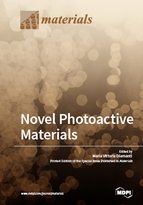Novel Photoactive Materials
A special issue of Materials (ISSN 1996-1944). This special issue belongs to the section "Optical and Photonic Materials".
Deadline for manuscript submissions: closed (30 September 2018) | Viewed by 42506
Special Issue Editor
Interests: titanium dioxide; titanium anodizing: anodic oxidation, plasma electrolytic oxidation, TiO2 nanotubes; TiO2 coatings for photocatalysis, self-cleaning, corrosion resistance; self-cleaning materials for the built environment; interference colors in thin films
Special Issues, Collections and Topics in MDPI journals
Special Issue Information
Dear Colleagues,
Photoactivity represents the ability of a material, generally speaking a semiconductor, to become active when interacting with light. It can be declined in many ways, and several functionalities arising from this behavior of materials can be exploited, all leading to positive repercussions on our environment. There are three main classes of effects of photoactivity on our everyday life, all of which have been deeply investigated in the last few decades, allowing to develop more and more efficient materials and devices:
- Energy production as a consequence of sunlight absorption, which is the principle of photovoltaic devices of all generations, be them silicon based, dye sensitized solar cells or thin films;
- Environmental cleanup as a result of photocatalytic degradation of pollutants, both in gas phase and in liquid phase, which is currently exploited in air purification devices and water remediation reactors;
- Cleaner and clearer surfaces thanks to photoinduced superhydrophilicity and related self-cleaning effects, which find relevant applications in building materials due to their lower requirements for maintenance and potentially higher durability.
All of them share a common point, that is, the interaction of a material with light, although many different materials are taken into account depending on the effect desired—from elemental semiconductors like silicon, to more complex compounds like CdTe or GaAs, to metal oxides like TiO2 and ZnO. Given the broadness of the field, a huge number of works fall within this topic, and new areas of discovery are constantly explored.
You are all invited to submit a manuscript for this Special Issue, in the form of research papers, communications, or reviews.
Assoc. Prof. Maria Vittoria Diamanti
Guest Editor
Manuscript Submission Information
Manuscripts should be submitted online at www.mdpi.com by registering and logging in to this website. Once you are registered, click here to go to the submission form. Manuscripts can be submitted until the deadline. All submissions that pass pre-check are peer-reviewed. Accepted papers will be published continuously in the journal (as soon as accepted) and will be listed together on the special issue website. Research articles, review articles as well as short communications are invited. For planned papers, a title and short abstract (about 100 words) can be sent to the Editorial Office for announcement on this website.
Submitted manuscripts should not have been published previously, nor be under consideration for publication elsewhere (except conference proceedings papers). All manuscripts are thoroughly refereed through a single-blind peer-review process. A guide for authors and other relevant information for submission of manuscripts is available on the Instructions for Authors page. Materials is an international peer-reviewed open access semimonthly journal published by MDPI.
Please visit the Instructions for Authors page before submitting a manuscript. The Article Processing Charge (APC) for publication in this open access journal is 2600 CHF (Swiss Francs). Submitted papers should be well formatted and use good English. Authors may use MDPI's English editing service prior to publication or during author revisions.
Keywords
- photocatalysis
- photovoltaics
- self-cleaning
- superhydrophilicity
- semiconductor
- metal oxide







